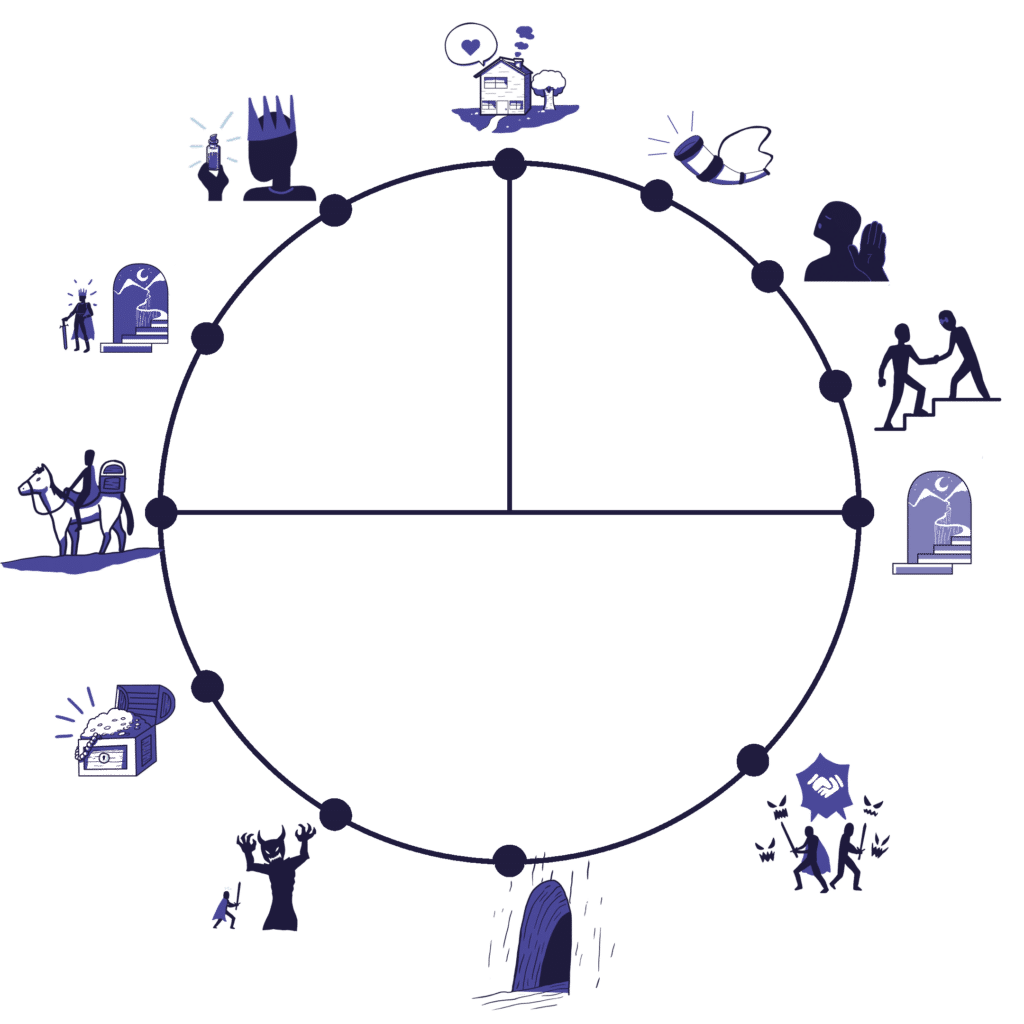Heroes behind the Logo: B2B Company Storytelling, Part 1
When you hear the word storytelling, you probably first think of an example like this one:

And isn’t that beautiful? Traveling and cooking, two such emotional topics! People laugh, they enjoy, they indulge in the dolce vita in Bella Italia – all thanks to airbnb aka one of the really big brands when it comes to storytelling.
But what if the product you offer as a company is not emotional at first glance? What if it is perhaps even very technical? And what if, to make matters worse, the customers are not the enchanting Nonna and her guests, but strictly speaking not even people, but other companies? Does that mean storytelling is off the table? Of course not at all! In our “Heroes behind the logo” series, we show great examples of how B2B companies can also tell really great stories. Part 1 focuses on the company itself and its hero’s journey.

The B2B Company as Hero: Authentic Brand Storytelling
Whether B2B or B2C, if you want good storytelling, you can’t avoid the hero’s journey model. From Star Wars to Lord of the Rings or Harry Potter, pretty much every successful narrative format follows a protagonist on a journey from his or her familiar world into adventure. The heroes face trials, enemies, but also allies; they have to overcome crises and grow as characters in order to return to their everyday lives with the elixir at the end. And of course B2B companies can also look at their own history in the same way.
Which protagonists are behind the logo? What was your reason for founding the company in the first place? What is the vision behind your product? But also: What trials and crises have they already experienced in the company’s history and how has this path shaped them?
Anyone who speaks authentically about their career and their values always creates identification potential and, ideally of course, sympathy among the potential target group – regardless of how technical the product is. Because at the end of the day, every B2B company has a clear mission to improve the situation of other companies in one way or another, and that is tangible for everyone. These companies provide the best evidence:
HubSpot: Growing Better Together and still Nowhere near the Finish Line
HubSpot is a great example of how B2B companies can use storytelling to simply express what drives them. As a provider of a comprehensive CRM platform, they have a technical product that probably only very few people understand in detail. On their “About us” page, they still manage to describe quite simply what their work brings to other companies.
“We believe that companies can grow with heart and conscience – and that the inbound methodology offers the right tools for this. That’s why we have developed cross-platform software, designed appropriate training courses and built a global community to support companies in this endeavor.”
HubSpot Mission
They then let Co-CEO Brian Halligan talk about their own reputation, i.e. the start of their corporate hero’s journey, and their vision for the future via video: “When I first met Dharmesh at MIT, we were immediately on the same wavelength. We were excited about new technical possibilities and the idea of helping companies grow. The day after we graduated, we decided to start a company together.” Incidentally, this is not the only place where they are actively giving the logo a face. The icing on the cake in terms of corporate identity is provided at the end by the HubSpot Culture Code, which vividly (and quite humorously) illustrates the DNA of cooperation, its values and approaches.
Salesforce: Raising the Curtain on 20 Years of Company History
Cloud software giant Salesforce is also making good progress when it comes to B2B storytelling. The “About us” page has everything you need for a good story: from your vision to strong corporate values and employee stories. The highlight is the video for their 20th anniversary, because a lot has already happened in their hero’s journey. From the beginnings of the Internet, to the launch of the first cell phones, to a socially networked world – Salesforce has seen it all and, above all, helped shape it for other companies.
In classic “from dishwasher to millionaire” style, the makers take their viewers on a very personal adventure: the humble beginnings in their own home, a grand vision, the first milestones in the basement office, anecdotes from the first employees, many allies and mentors who have accompanied the journey and, of course, company dogs and cuddly mascots! The likeable appearance not only conveys the culture and atmosphere in the company in a great way, but also creates a lot of identification potential, so that in the end everyone more than begrudges them their enormous success.
You can find out more about Salesforce’s storytelling in another blog post: 20 years of Salesforce – a success story
Basecamp: B2B-Storytelling in Letter Form
Considering that project management veteran Basecamp started out as a design company, their “About Us” page is probably one of the simplest ever. No chichi, no videos, no big speeches about values and missions, just a letter. Not just any message, however, but a personal one from co-founder and managing director Jason Fried.
„I wish I could credit a spark of genius, or some deep insight. But I can’t. Truth is, we built Basecamp out of desperate necessity. We needed it bad. Without it, we were embarrassing ourselves..“
Jason Fried – Basecamp
The CEO masterfully recounts the company’s hero’s journey in his own words in a way that is easy to understand and can be followed by any entrepreneur. The start as the design company 37signals, the first successes in the form of many orders and the first tests that came with them: The previous system for organizing ourselves internally was slowly but surely put to the test.
„It wasn’t that we didn’t have the skills — we just didn’t have the right tools, nor the method, to juggle the additional workload. We were disorganized, we were dropping balls, and stuff was slipping.”
Jason Fried – Basecamp
And then the catastrophe: The company’s own customers notice the increasingly poor quality of the work before the team itself acknowledges the shortcomings. embarrassing. But every crisis is (hopefully) followed by a resurrection, and the call for Basecamp was born! The 37signals clients, who were originally invited to collaborate, quickly realized what an enormous help the project management tool was. And suddenly the design business was passé. Instead, the team focused entirely on Basecamp, which today supports thousands of companies worldwide. What a nice reward.
„It’s been an incredible ride so far, and we have so many people to thank. But most of all, we feel a deep sense of responsibility to continue to make the best product we can for companies who desperately seek a better way to work. We’re here for them, 23 years and running.“
Zendesk: Master of the Hook
Last but not least, a wonderful example of how it doesn’t always have to be a long story to arouse sympathy. Small insights and anecdotes are often enough to give a B2B company character and make potential customers and talents curious about working together.
Customer service platform Zendesk also has an “About us” page, but you won’t find a long company history here. Instead, they skillfully reveal small snippets and lead to further information in the right places. If those aren’t great hooks!

Who wouldn’t want to know more after the actually meaningless anecdote about the foundation on a table, a door or a kitchen table? Where is this door/table/beer catcher today? At the same time, readers get a direct impression of the mood in the company. The atmosphere in the Zendesk offices is obviously relaxed, people talk and sometimes sit together at table doors. Sounds like a wonderful working atmosphere!
But as you know from parties, if you only ever talk about yourself, you often end up alone. That’s why, in part 2 of our series, we reveal the (even more important) role B2B companies can also play in storytelling. Stay tuned!
Share this article









